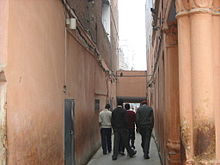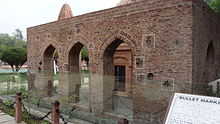Jallianwala Bagh: Difference between revisions
No edit summary Tags: Mobile edit Mobile web edit |
|||
| Line 30: | Line 30: | ||
{{citations missing|date=February 2014}} |
{{citations missing|date=February 2014}} |
||
''(Taken from main page)''<br/> |
''(Taken from main page)''<br/> |
||
On |
On 10 April, [[Brigadier General]] [[R.E.H. Dyer]]<ref>{{cite book|title=Jallianwala Bagh commemoration volume and Amritsar and our duty to India|year=1994|publisher=Publication Bureau, Punjabi University|isbn=978-81-7380-388-8|url=http://books.google.co.in/books?id=ZARuAAAAMAAJ}}</ref><ref>{{cite book|last=Datta|first=Vishwa Nath|title=Jallianwala Bagh|year=1969|publisher=[Kurukshetra University Books and Stationery Shop for] Lyall Book Depot|url=http://books.google.co.in/books?id=kG0_AAAAMAAJ}}</ref> arrived from Jalandhar Cantonment, and virtually occupied the town as civil administration under Miles Irving, the Deputy Commissioner, had come to standstill. On Sunday, 13 April 1919, Dyer was convinced of a major insurrection and he banned all meetings, however this notice was not widely disseminated. That was the day of Baisakhi, the main Sikh festival, and many villagers had gathered in the Bagh. On hearing that a meeting had assembled at Jallianwala Bagh, Dyer went with fifty Gurkha riflemen to a raised bank and ordered them to shoot at the crowd. Dyer continued the firing for about ten minutes, until the ammunition supply was almost exhausted; Dyer stated that 1,650 rounds had been fired, a number which seems to have been derived by counting empty cartridge cases picked up by the troops. Official British Indian sources gave a figure of 379 identified dead, with approximately 1,100 wounded. The casualty number estimated by the Indian National Congress was more than 1,500, with approximately 1,000 dead. |
||
[[File:Jalian Wala Bagh Memorial 311.jpg|thumb|The narrow lane used for entering the park premises.]] |
[[File:Jalian Wala Bagh Memorial 311.jpg|thumb|The narrow lane used for entering the park premises.]] |
||
Revision as of 20:18, 31 August 2015
| Jallianwala Bagh | |
|---|---|
| Native name Hindi: जलियांवाला बाग | |
 Jallianwala Bagh memorial, Amritsar | |
| Location | Amritsar, Punjab, India |
Jallianwala Bagh , Hindi: जलियांवाला बाग) is a public garden in Amritsar in the Punjab state of India, and houses a memorial of national importance, established in 1951 by the Government of India, to commemorate the massacre by British occupying forces of peaceful celebrators including unarmed women and children, on the occasion of the Punjabi New Year on April 13, 1919 in the Jallianwala Bagh Massacre. Colonial British Raj sources identified 379 fatalities and estimated about 1100 wounded.[1] Civil Surgeon Dr. Smith indicated that there were 1,526 casualties.[2] The true figures of fatalities are unknown, but are likely to be many times higher than the official figure of 379.
The 6.5-acre (26,000 m2) garden site of the massacre is located in the vicinity of Golden Temple complex, the holiest shrine of Sikhism.
The memorial is managed by the Jallianwala Bagh National Memorial Trust, which was established as per the Jallianwala Bagh National Memorial Act passed by the Government of India in 1951.


Jallianwala Bagh massacre
This article needs additional citations for verification. (February 2014) |
(Taken from main page)
On 10 April, Brigadier General R.E.H. Dyer[3][4] arrived from Jalandhar Cantonment, and virtually occupied the town as civil administration under Miles Irving, the Deputy Commissioner, had come to standstill. On Sunday, 13 April 1919, Dyer was convinced of a major insurrection and he banned all meetings, however this notice was not widely disseminated. That was the day of Baisakhi, the main Sikh festival, and many villagers had gathered in the Bagh. On hearing that a meeting had assembled at Jallianwala Bagh, Dyer went with fifty Gurkha riflemen to a raised bank and ordered them to shoot at the crowd. Dyer continued the firing for about ten minutes, until the ammunition supply was almost exhausted; Dyer stated that 1,650 rounds had been fired, a number which seems to have been derived by counting empty cartridge cases picked up by the troops. Official British Indian sources gave a figure of 379 identified dead, with approximately 1,100 wounded. The casualty number estimated by the Indian National Congress was more than 1,500, with approximately 1,000 dead.



Etymology
The place derives its name from that of the owners of this piece of land in Sikh times. It was then the property of the family of Sardar Himmat Singh (Sikhism) (d.1829), a noble in the court of Maharaja Ranjit Singh (1780-1839), who originally came from the village of Jalla, now in Fatehgarh Sahib district of the Punjab. The family were collectively known as Jallhevale or simply Jallhe or Jalle, although their principal seat later became Alavarpur in Jalandhar district. The site, once a garden or garden house, was in 1919 an uneven and unoccupied space, an irregular quadrangle, indifferently walled, approximately 225 x 180 meters which was used more as a dumping ground than anything else.
References
- ^ Home Political Deposit, September, 1920, No 23, National Archives of India, New Delhi; Report of Commissioners, Vol I, New Delhi
- ^ Report of Commissioners, Vol I, New Delhi, p 105
- ^ Jallianwala Bagh commemoration volume and Amritsar and our duty to India. Publication Bureau, Punjabi University. 1994. ISBN 978-81-7380-388-8.
- ^ Datta, Vishwa Nath (1969). Jallianwala Bagh. [Kurukshetra University Books and Stationery Shop for] Lyall Book Depot.
External links

